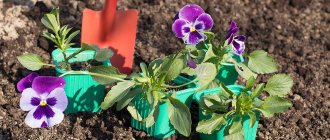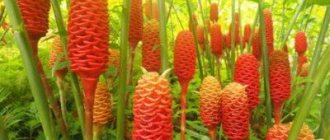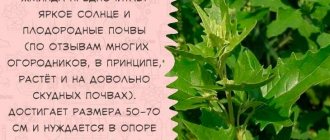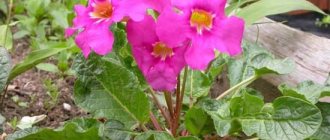Description of the plant
Viola is a herbaceous plant representing the violet family and numbering about four hundred different species. It can be annual or perennial. Both varieties of flowers, which are also known as tricolor violet and pansy, are grown in the garden.
Viola grows wild in countries with a subtropical climate. It can be found in Africa, Australia, America and New Zealand. Some types of pansies grow in temperate continental climates in European and Asian meadows.
The viola forms a compact bush about 15-20 cm high (see photo). A long peduncle (25-30 cm) is formed from the rosette, on which sits a single flower, the diameter of which can reach 5-8 cm. The color of the petals is bright and juicy. It usually includes three colors. But now single-color varieties have been bred.
Viola blooms either in early spring or late summer. In the first case, the flowers fade already in June, and in the second they continue to open until mid-October. Pansies produce fruits in the form of boxes with opening flaps.
Violas are used in landscape design to design long rectangular flower beds (edges) and borders. It is used to frame flower beds and cover empty spaces between medium and tall perennial flowers. Violets with small flowers are suitable for decorating an alpine hill or rock garden. Some varieties are suitable for growing in containers.
Viola Williamsii
Viola Williams is a biennial hybrid obtained from crossing Wittrock's viola and horned viola. The stem of the Williams viola can reach 30 cm, the flowers are small - 3-4 cm. Their color is always bright, with strokes similar to the coloring of the flowers of the Wittrock viola, but without the characteristic “face”.
Ampelous Williams violas in flower pots
Among the varieties of Williams viola, there are not only bush forms, but also hanging forms.
Popular varieties:
- “Pearl Falls” - ampelous viola, many white and blue flowers, pleasant smell.
- "Bengal fire" - ampelous viola, yellow-burgundy butterfly flowers.
- "Amber Kiss" is a bush that forms a lush carpet with bright bronze-yellow flowers.
- “Froze chocolate” is a bush form that tends to quickly grow in width; opens many small flowers at the same time; The color of the flowers is brown with a yellow eye and dark strokes.
Luxurious Williams viola lashes in a hanging flowerpot
Types, varieties
Regardless of whether violas are perennial or annual, they can be divided into 3 groups:
- small-flowered;
- medium-flowered;
- grandiflora.
Popular small-flowered viola varieties:
- Blue boy . The color includes various shades of blue, blue and purple.
- Snow Maiden . The petals are white.
- Little Red Riding Hood . It is distinguished by the bright red color of its flowers.
Popular varieties of viola with medium flower size:
- Ice King . The main color is white. But the petals on top have shades of yellow and green. Purple spots are observed on the lower petals.
- Winter sun . Violets are colored intense yellow. Dark brown spots form on the lower petals.
- Heavenly Queen . At first the petals are colored blue. Then the color fades and becomes almost white.
- The magic of March . The flowers are dark purple. But as they open, they turn black.
- Jupiter . The color combines white and various shades of purple.
- Evening heat . The flowers are red with a brown tint. Darker spots of the same color can be seen on the petals.
Among the large-flowered violas, the most common are:
- Blue . The color includes not only blue, but also shades of purple. Dark spots are visible on the petals.
- White . The color is not pure white, but is combined with shades of yellow and green.
- Yellow . Yellow flowers shimmer with gold.
Attention! The diameter of the flowers of small-flowered varieties does not exceed 4 cm, and of medium-flowered varieties - 6 cm. Large-flowered varieties of pansies form flowers up to 8 cm in diameter.
Popular varieties and their names
Let's consider the classification and types of viola:
- Swiss giants are annual plants. Keeps flowering until the first frost. They grow not tall, 25-27 cm, with large blooms up to 7 cm in diameter.
- Bamibini are small bushes up to 20 cm tall. These varieties have a unique coloring with a white “butterfly” pattern inside the flower.
- Rococo - has a rich range of different colors of lilac, lilac, orange shades, with grooved edges. It can grow as an annual or biennial flower. In open ground it blooms from May to October.
Viola fragrant
A perennial plant with a thick rhizome and dense dark green basal leaves. The leaf plates are round in shape. Flowers with a pleasant, thick aroma, white or purple in color. Grows up to 15 cm in height.
Flowering occurs in May and sometimes repeats in autumn.
Gardeners love this variety for its fragrance. They are also grown in city flower beds, parks and gardens.
This includes varieties:
- Rosina - the leaves are located at the top, slightly to the side of the flower. The flower is pink and looks like a bird flapping its wings.
- The king is a lilac-colored flower.
- Charlotte - blooms with large purple flowers.
Viola hornata (cornuta) or ampelous
Grows up to 15-20 cm. The root system grows and forms a mat. The leaf blades have an oval-toothed shape.
One bush produces many inflorescences, which are located at the top on a long stem. Various shades, lilac, violet, lilac flowers with a yellow eye in the middle. There is a small horn on the outside of the flower.
Flowering is observed in autumn and spring.
They are quite frost-resistant, but insulation is recommended in winter.
Under varieties:
Balmont Blue
The bush's stems trail along the bottom and blooms in a soft blue color.
Ideal for growing in hanging pots, for decorating balconies, loggias and verandas.
Akright Ruby
It blooms with large bright red flowers with a yellow eye in the middle.
The stems grow from the bottom and have dark spots on them.
Purple Duet
A two-color variety, the upper two petals are burgundy, and the lower three are pink with dark splashes.
Viola Wittrock
This species belongs to perennial plants. Gardeners grow it as a biennial plant.
Grows up to 25-30 cm in height.
Leaf plates with wavy teeth are arranged alternately.
Flowering with single buds, different in shape and color, large in diameter.
Wittrock's viola is divided into several categories:
- According to the duration of flowering.
- According to the size of the flowers.
- According to the shape and color of flowering.
- According to frost resistance.
Dividing varieties by size and number of flowers, there are groups:
- Multiflora (multiflorous)
- Grandiflora (large-flowered)
Taking into account the color of the plant, they are divided into varieties:
- Single color
- Two-color
- Spotted
Single-color popular varieties:
- Viola White - with green leaf blades, the bush spreads widely across the ground, reaching a height of up to 0.2 meters.
White flower with yellow or green splashes. Situated on long stems. It blooms with a fragrant aroma from mid-spring to early summer. And also from September to October.
Tolerates winter well under good shelter.
- Blue Boy is a multi-flowered bush that can produce up to 20 flowers at a time. Petals are folded, bent back, bluish-lilac flowers.
The leaves are greenish-gray. The bush grows 0.25 meters high.
The flowering period is the same as that of white viola. It also tolerates winter well with reliable shelter.
- Viola Red - bright red flowers bloom on straight stems, in the middle of the petals there is a yellow eye.
Two-color ones include:
- Lord Beaconsfield - bush grows up to 25 cm. With small flowers.
The lower petals are dark purple with a wavy lilac edge. The upper ones are lilac-white with dark strokes. Up to 30 flowers bloom at the same time.
variety :
- Jupiter is a low bush up to 15 cm in height with dark green leaves.
The flowers are velvety to the touch, round in shape, up to 5-6 cm in diameter. The lower petals are purple, and the upper ones are bent towards the bottom, white at the base.
The variety belongs to the multiflora group and is frost-resistant.
Spotted varieties:
- Shalom Purim is a hybrid with large flowers of double, folded petals.
There are various shades.
When grown in shaded areas, the petals become even more corrugated.
They bloom twice a year.
- Hybrid F 1 Eyes of a tiger - has a stunning color.
The bright yellow petals are decorated with dark dashed lines. There is a dark, inky pattern at the base of the petals.
The flowers grow small, up to 3 cm in diameter. But flowering occurs very luxuriantly, with a pleasant aroma, throughout the summer.
Can be grown both in open ground and indoors.
Selection of location and conditions of detention
Growing viola is possible only if certain conditions are met. Let's find out what is needed for the healthy growth of a tricolor violet.
Lighting and location
Viola loves bright sun, but it should not shine on the flowerbed all day. Therefore, it is better to choose a place where the shadow falls on it closer to the middle of the day. You can plant violets near a high fence, against a wall or in the garden.
Temperature
The optimal temperature for growing viola in the garden is +18…+20 °C. But the flower can withstand night cold and even light frosts. And during the day it tolerates heat up to +30 °C and above.
Air and humidity
Flowers thrive in moderately humid air (50-70%). Overwatering can lead to the development of fungal infections. It is better not to place pansies in a draft.
Priming
Tricolor violet likes to grow in humus-rich, loose and moist soils with a neutral reaction. Flowers love it when the soil contains black soil, humus, river sand and high-moor peat. They respond well to the addition of wood ash: it enriches the soil and neutralizes acids in it.
Botanical description
Viola belongs to the violet family. It is grown as annual, biennial and perennial shrubs. This herbaceous plant reaches a height of up to 30 m.
The leaves have small stipules. The shape of the leaf blade can be varied: dissected, pinnate, simple. The leaves can be arranged singly or form a basal rosette.
The flowers are solitary, formed in the axils of the leaves on a long peduncle. In the lower part the petals are larger due to slight thickening. The shape of the flowers is varied: simple, semi-double or double. The color can be two or three colors, with small inclusions and single spots.
The plant blooms very profusely. The beginning of flowering depends on the time of planting the flower. It usually begins at the end of March and lasts until the first frost.
After the flowering period, fruit boxes filled with small seeds ripen on the viola. Seed germination is very high. It can last for two years.
When to plant
Sowing dates for perennial viola for various regions of Russia:
- October or May (planting before winter or spring) for central Russia;
- September or June for the northern regions of the country;
- November or April for the southern regions.
Annual varieties of tricolor violets are usually sown as seedlings in March (in the north in April, and in the south in February). Then it begins to bloom early. But you can plant viola directly in the ground. Then flowering will begin 1-2 months later. Planting of seedlings or sowing of seeds into open ground is carried out in May (in the north in June, and in the south in April).
Features of care
The root system of this flower is superficial and is located at a depth of 15 to 20 centimeters. In this regard, it is necessary that the soil is slightly moist and loose at all times. Watering is carried out only when there is a prolonged dry and hot period. If it rains regularly in the summer, then there is no need to water the pansies. It is also necessary to promptly pull out weeds and remove faded flowers so that the flowering remains lush.
Also, these beautiful flowers need to be fertilized regularly. To do this, fertilize with superphosphate or ammonium nitrate once every 4 weeks (take 25 to 30 grams of the substance per 1 m2).
Diseases and pests
Caring for viola is quite simple, and if you strictly adhere to the rules and carry out all the necessary procedures on time (watering, weeding, loosening, fertilizing), then your flowers will always look incredibly impressive, and they will not get sick, and they will not be disturbed by harmful insects . Often such a plant suffers from powdery mildew. In an infected specimen, a whitish or grayish coating appears on the surface of leaf blades, buds and stems. Viola can get sick due to the fact that it is constantly fed with fertilizer containing nitrogen, and the disease can also be triggered by heavy dew in the morning during the relatively dry summer period. Diseased bushes must be treated with soda ash, to which you need to add foundation, soap or ground sulfur. If the bush does not recover, then after half a month the treatment must be repeated.
Pansies can also get sick with black leg or gray rot. The reasons for the development of these diseases are: inappropriate temperature conditions, disturbances in soil or air humidity. Try to eliminate the cause of the disease, otherwise the rest of the bushes will become infected. Do not forget to dig up and destroy the infected plants, and you need to water the area where they grew with a foundation solution.
In some cases, this flower may develop spotting. The leaf blades of an infected bush begin to dry out, while the flower itself weakens. Be sure to dig up infected bushes. Experienced gardeners recommend burning them so that the disease cannot spread further. The remaining healthy specimens should be subjected to preventive treatment. To do this, they need to be sprayed with Bordeaux mixture 2 or 3 times, and the intervals between treatments should be 14 days.
This flower is particularly dangerous for the violet and clover moth caterpillars, which feed on the leaves of this plant. In order to get rid of pests, plants should be treated with infusion of tobacco or chlorophos.
Growing from seeds in open ground
Planting viola seeds in open ground step by step:
- Prepare the area in advance: dig it up and fertilize it if the soil is poor. For every sq. meter, add a bucket of humus and 1 liter of wood ash.
- Make grooves at a distance of 10-15 cm from each other.
- Sow the seeds and cover them with soil. Better yet, mulch the grooves with humus.
- Water the flowerbed.
Keep the soil moist until the first shoots appear. Flowers planted this way in May will begin to bloom at the end of August. If they are planted before winter, flowering will begin in early spring.
Viola Wittrock: cultivation
Viola is hardy and frost-resistant; it grows well in the shade, although in the sun it blooms more profusely and its flowers are larger. Therefore, choose a site that is as sunny as possible, located at some elevation, without close access to groundwater. It has been noted that violet can grow successfully on any soil, even the heaviest, but prefers moist, fertile loam. Before planting the plant, the soil on the site should be prepared by digging with a shovel and adding 10 kg of humus and peat and 5 kg of sand per 1 square meter.
Growing seedlings
In order for the viola to begin flowering in the summer, it must be planted as seedlings in early March. You need to do it like this:
- Buy soil for violets at a flower shop or mix peat, humus and river sand in a ratio of 2:2:1. You can add a little black soil or garden soil.
- Fill the bowl with soil and make several grooves at a distance of 2-3 cm from each other.
- Soak viola seeds for 30 minutes in a solution of Epin or Zircon (2 drops per 1 liter of water).
- Take out the seeds and sow them in the furrows and cover them with soil so that the planting depth is about 4-5 mm.
- Moisten the soil and cover the bowl with film, place it in a cool place (temperature about 15 ° C).
- When the first shoots appear, remove the film and transfer the container with the seedlings to an even cooler place (about 10 ° C). The room should be light enough. From time to time the soil in the bowl needs to be moistened.
- When the seedlings have 2 true leaves, they need to be transplanted into a new container, keeping a distance of 3-4 cm between the picked violets.
- After 14-20 days, make a second pick of seedlings either into containers or into seedling cups according to a 6x6 cm pattern.
- Over time, the temperature in the room needs to be raised to +18…+20 °C. Continue watering the seedlings.
Plants can be planted in the ground in May or early June.
Reproduction methods
- Seeds
- Seedlings
- By cuttings
If the seeds are sown in open ground at the end of summer, then next year, from spring to autumn, the viola will already bloom.
Even seeds collected 2 years ago do not lose their ability to germinate.
Planting seedlings, necessary steps:
- Prepare a wooden or plastic container for planting.
- Make furrows in the soil and sow pre-soaked seeds (30-60 minutes is enough)
- Sprinkle sand or fine earth on top.
- Moisten with a spray bottle and cover the container with film.
- Before sprouts sprout, remove the film periodically for ventilation. After germination, the film is removed.
Germination will depend on the viola variety. As a rule, sprouts appear in 7-10 days.
Sprouted seedlings are placed in a cool, bright place, protected from sunlight.
After 2 weeks, thinning must be done by removing weak seedlings.
After 2-3 leaves appear on the young sprout, they are planted in separate pots.
Soil for seedlings can be purchased ready-made; soil for violets is suitable. Or mix sand, peat, humus yourself (1:1:1)
Carry out timely watering, preventing the top soil from drying out.
Before the onset of warm temperatures, plants adapt to the external environment, periodically ventilating the room.
With the appearance of 6 leaves, the plants are transplanted either into a pot on a covered balcony, by the end of March.
Or in May the plants are planted in open ground.
On a note!
How to distinguish perennial flowers from annual ones.
Seeds of annual violas are planted for seedlings in February-March, and perennial varieties are planted in open ground in winter.
Propagation by cuttings is carried out from May to July. Reproduction at a later time will produce flowering only next year.
To do this, deepen the cut cuttings by about 0.5 cm into prepared separate pots or glasses with moist soil.
Only healthy, growing shoots with 2-3 internodes are suitable for cuttings.
For favorable rooting of cuttings, sufficient humidity is necessary. You can create it from a fabric cap, which needs to be regularly moistened.
After 3-4 weeks, the cuttings will take root.
If you plant cuttings in open ground at the end of May to July, they will take root and bloom by autumn.
Planting seedlings in open ground
Planting seedlings in the ground is very simple. You just need to remove the seedlings from the container or seedling cups and plant them according to the 10x10, 10x15 or 15x15 cm scheme, depending on the height of the variety. They need to be buried to the same level. After planting, the flowerbed needs to be watered abundantly.
Advice! Plant pansy seedlings on a cloudy day to help seedlings set in faster.
Features of the viola
Representatives of viola can be annuals, biennials and perennials. This herbaceous plant reaches a height of 15–30 centimeters. The root system is fibrous, the main stem is erect. Leaf blades with stipules can be pinnately dissected or simple. They grow alternately or are part of a basal rosette. Single axillary flowers, reaching a diameter of 7 centimeters, are located on fairly long peduncles. The petals located at the top have marigolds, and at the bottom they have a larger size and a bag-like formation (spur) located at the base. The shape of flowers and color can be very different, for example: two or three colors, plain, striped, spotted, with 1 spot, with a smooth or wavy edge of the petals, double or simple, etc. The flowering of this plant is incredibly abundant. Depending on when the plant was planted, flowering can be observed from the second half of March to the end of spring, or from August until frost. There are hybrids that bloom throughout the summer or 2 times per season. The fruit is a capsule containing seeds inside. Their high germination rate persists for a couple of years.
This is a frost-resistant plant that thrives in the shade. However, in a shaded place it blooms less abundantly, and the flowers themselves become smaller. Loamy, moist soil rich in nutrients is best suited for planting. If you plant such a flower on dry sandy soil, then as a result the flowers will also become smaller.
How to grow pansies. Garden World website"
Rules for caring for and growing in the garden
Let's find out how to properly care for a viola planted in a flowerbed in open ground.
Watering
You need to water depending on the weather. If it rains regularly, the plant does not need to moisten the soil. During the dry period, you need to water the flower beds with violets every day or every other day in the morning or evening. It is better to do this with warm water, standing in a container outside. After the end of flowering, annual varieties of pansies can no longer be watered, but perennials will require watering unless there is rain for a long time.
Top dressing
Once a month, viola needs to be fed with complex fertilizers for flowering plants. It is enough to dilute 10-15 g of such fertilizer in a bucket (Kemira-Lux, Zdraven) and water the flowerbed with it (consumption - 5 liters per m2). But you need to water at the root: a concentrated solution of fertilizers if it gets on the leaves can cause them to burn. The first feeding begins 2 weeks after planting the seedlings. The latter is carried out in October (for perennials).
Loosening, mulching
The soil in the flower bed with violas should be kept loose. Therefore, it needs to be loosened after each watering. You can add a layer of mulch. Then there will be no need for loosening.
Pinching, pinching, pruning
Forming a viola bush is optional. However, the bush will be neater and more lush if you pinch the growing point after the formation of the third pair of true leaves.
Transfer
One-year-old viola does not need replanting. However, it can be replanted directly during flowering if you decide that it should decorate some other area.
Perennial varieties of pansies grow quickly. Plantings become denser, causing bushes and flowers to become small and inconspicuous. Therefore, they need to be replanted every 2-3 years.
Features of planting and care
Before growing violets, it is necessary to study its varietal characteristics and cultivation techniques. Viola is a winter-hardy and shade-tolerant plant. However, you should pay attention to the choice of location for the flower bed. Lack of sunlight will affect the duration of flowering. Hot, open sunlight will speed up the flowering period and make it short. The peduncle with bud will stretch out, and the size of the flower will become small. The best place for growing violets will be a place open to sunlight in the morning and evening and with shade during the day.
Violet needs protection from drafts. Planting a plant on an alpine hill will help to get excellent results. The optimal temperature for growing flowers is 15 °C.
For the proper development , growth and reproduction of viola, it needs fertile soil. The flower grows well on loamy and sandy soil. In this case, the plant needs to provide good drainage. The absence of excess moisture will preserve the root system of the flower, which is located superficially in the violet, from damage by rot and disease. When setting up a flower bed, the soil is dug up and sand and peat are added. The composition is thoroughly mixed.
Viola responds well to various types of fertilizers and fertilizing. The florist can use purchased mineral mixtures and fertilize . Organic fertilizers can be used. The only thing that viola cannot tolerate is feeding with fresh manure. The plant dies.
Flowers require periodic and moderate watering. The flower can withstand drought, but this will affect flowering, so it is necessary to water the flowerbed as the top layer of soil dries.
Violet loves loosening , so it provides its root system with oxygen. It is not worthwhile to loosen deeply; the roots can be easily damaged.
Wintering, collecting seeds
Annual violets do not overwinter. Their aboveground part is removed and destroyed. And perennials are covered with a heap of dry leaves, sawdust or straw. This is enough for the viola to survive the winter.
After flowering, viola forms fruits in the form of boxes. They contain seeds that can be collected and sown next year. The timing of seed collection depends on the flowering time. In any case, you need to wait until the box is completely dry and, when squeezed in your hands, begins to crack and burst, releasing the seeds. At this time they need to be collected. Store seeds in paper bags in a cool, dry place.
Plant care
The root system of the viola is located quite shallow, so watering this flower should be regular. But you should not allow water to stagnate. In addition, the viola responds gratefully to loosening. It is best to cover the viola for the winter. For this, a small layer of spruce branches, peat or leaves will be enough.
Loosen the soil around the viola carefully so as not to damage the root system. Tip. To prolong the flowering of viola, remove faded flowers and seed pods.
Features of cultivation
Viola may suffer from the following diseases:
- powdery mildew (white coating with a gray tint on leaves and flowers);
- black leg (the base of the shoot turns black and dries out, the entire bush dies);
- spotting (brown or almost black spots on the leaves);
- gray rot (affects buds and flowers).
These diseases are caused by various fungi and develop when moisture stagnates in the soil. Treatment of violets consists of removing damaged parts of the plant and treating them with a 0.2% solution of Fundazol. Sprinkling the bushes with wood ash or ground sulfur also helps against fungal infections. As a preventive measure during the rainy season, it is useful to spray pansies with Bordeaux mixture.
Various caterpillars become pests of viola: they eat the leaves of flowers to holes. It is difficult to fight them manually. It is best to treat plants with chlorophos or any insecticide (Aktellik, Inta-vir).
Viola is a compact and relatively low-growing plant. But this does not prevent it from forming large flowers, reminiscent of elegant children's dresses of various colors. It can bloom at any time: spring, summer or autumn. It depends only on when you plant the violet as seedlings or in open ground.
Diseases and pests
With proper care, the viola plant practically does not get sick. Otherwise, the flower may be affected by the following diseases:
- powdery mildew;
- blackleg;
- root rot;
If signs of disease are detected on plantings, they should be treated with a solution of soda ash and laundry soap. You can also use ready-made fungicidal agents. If necessary, plants are re-treated.
The viola plant can be affected by mother of pearl caterpillars and violet cutworm, which destroy the leaves of the plant. To kill pests, use tobacco infusion or insecticidal preparations according to the instructions.
At the end of the flowering period, seeds are collected. In place of the flowers, a box filled with seeds is formed. The boxes are collected after it opens up and stored in the refrigerator. If the seeds are not collected on time, they will sow on their own.
Viola is an unpretentious plant that amazes with its many shapes and colors. With the right choice of planting site and proper care, it will become a decoration of your garden plot.











